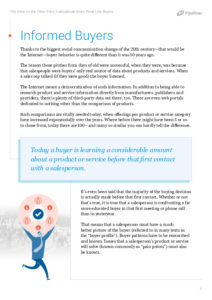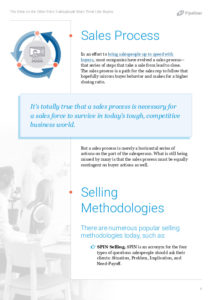There is a long-term situation in sales of salespeople having a rather one-sided viewpoint: they think only like salespeople. It’s all about the pitch—selling points that they’ve seen work before, and using those to convince that buyer to purchase.
Salespeople have been operating this way since the beginning of time. The better salespeople perfected their pitches so they could recite them in their sleep—and sometimes it seemed that they were doing exactly that.
But the salesperson of old wouldn’t stand a chance in today’s sales landscape. One vital element in the sales-buyer relationship has radically changed: the buyer.
Radical Shift
Today a buyer is learning a considerable amount about a product or service before that first contact with a salesperson. It’s even been said that the majority of the buying decision is actually made before that first contact. Whether or not that’s true, it is true that a salesperson is confronting a far more educated buyer in that first meeting or phone call than in yesteryear.
Where a great sales pitch used to work before, today it’s a whole different game. A salesperson must learn all about the various actions a buyer takes in making a purchase, and most importantly learn to be rapidly responsive to those actions in ways that are meaningful and motivational.
If you think back to sales you’ve been involved with, you’ll realize that in deals that won, you successfully monitored various buyer actions in coordination with taking actions of your own. In deals which were lost, there had to have been actions you didn’t take, or at the least key indicators you missed.
To the degree that due regard for buyer actions is taken, the sale is succeeding.
Sales Process
In an effort to bring salespeople up to speed with buyers, most companies have evolved a sales process—that series of steps that take a sale from lead to close. The sales process is a path for the sales rep to follow that hopefully mirrors buyer behavior and makes for a higher closing ratio.
Selling Methodologies
There are numerous popular selling methodologies today. Consultants are hired to bring in one of these or another such method. Interestingly, each of them seeks to make it possible for a sales rep to monitor, influence and be responsive to buyer actions.
Selling System
To emphasize the importance of buyer actions and seller’s activities, we at Pipeliner recently evolved the Pipeliner Selling System. This system, which could be called a common denominator for all successful sales processes, shows that a seller can not simply march through a sales process, but must be acting to cause—and be responsive to—the various buyer actions all down the line.
What does all this mean for your sales team…and for the CRM solution that you choose? You owe it to yourself and your organization to find out.
Download our free white paper The Shoe on the Other Foot: Salespeople Must Think Like Buyers.



































Comments